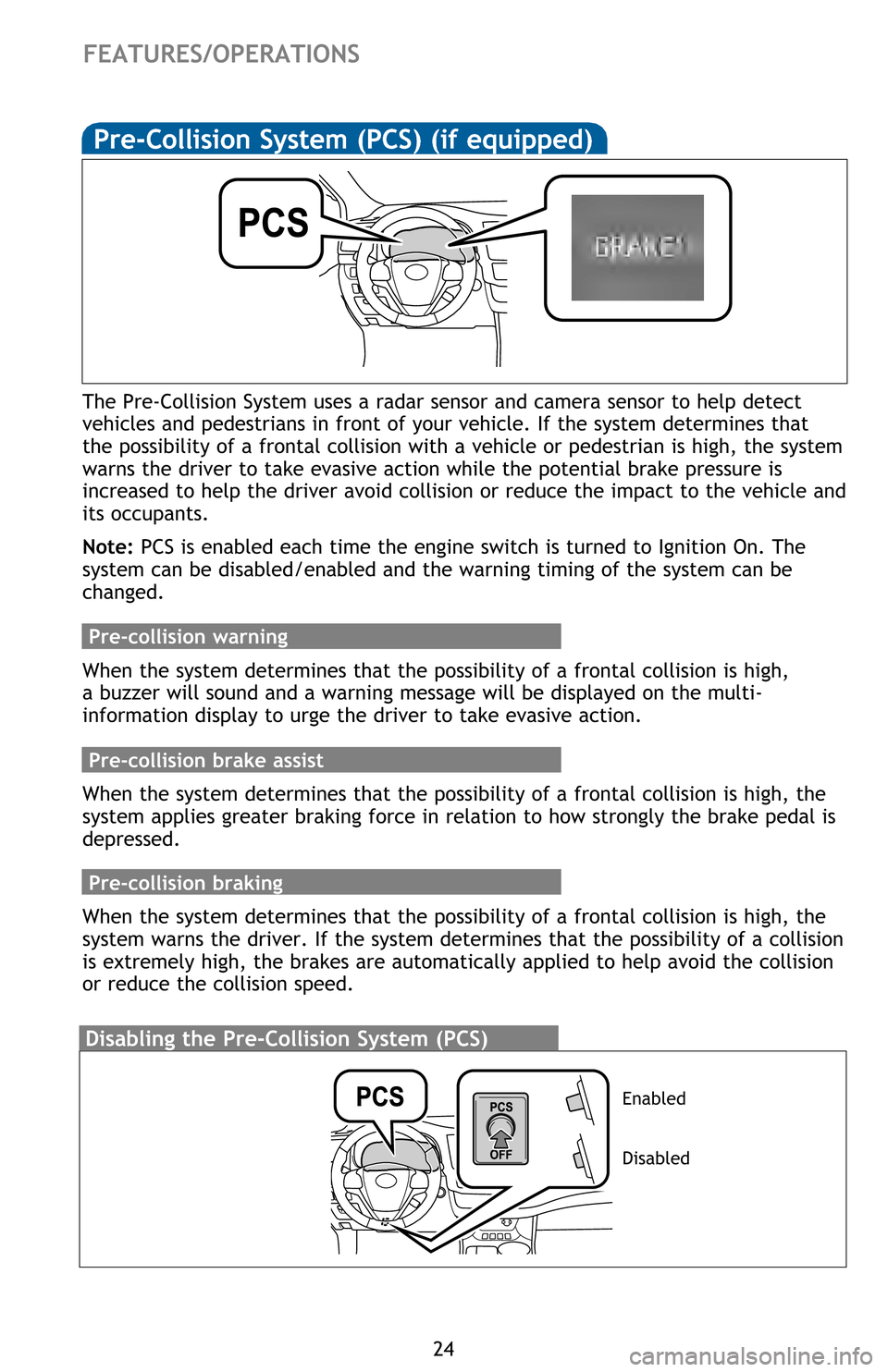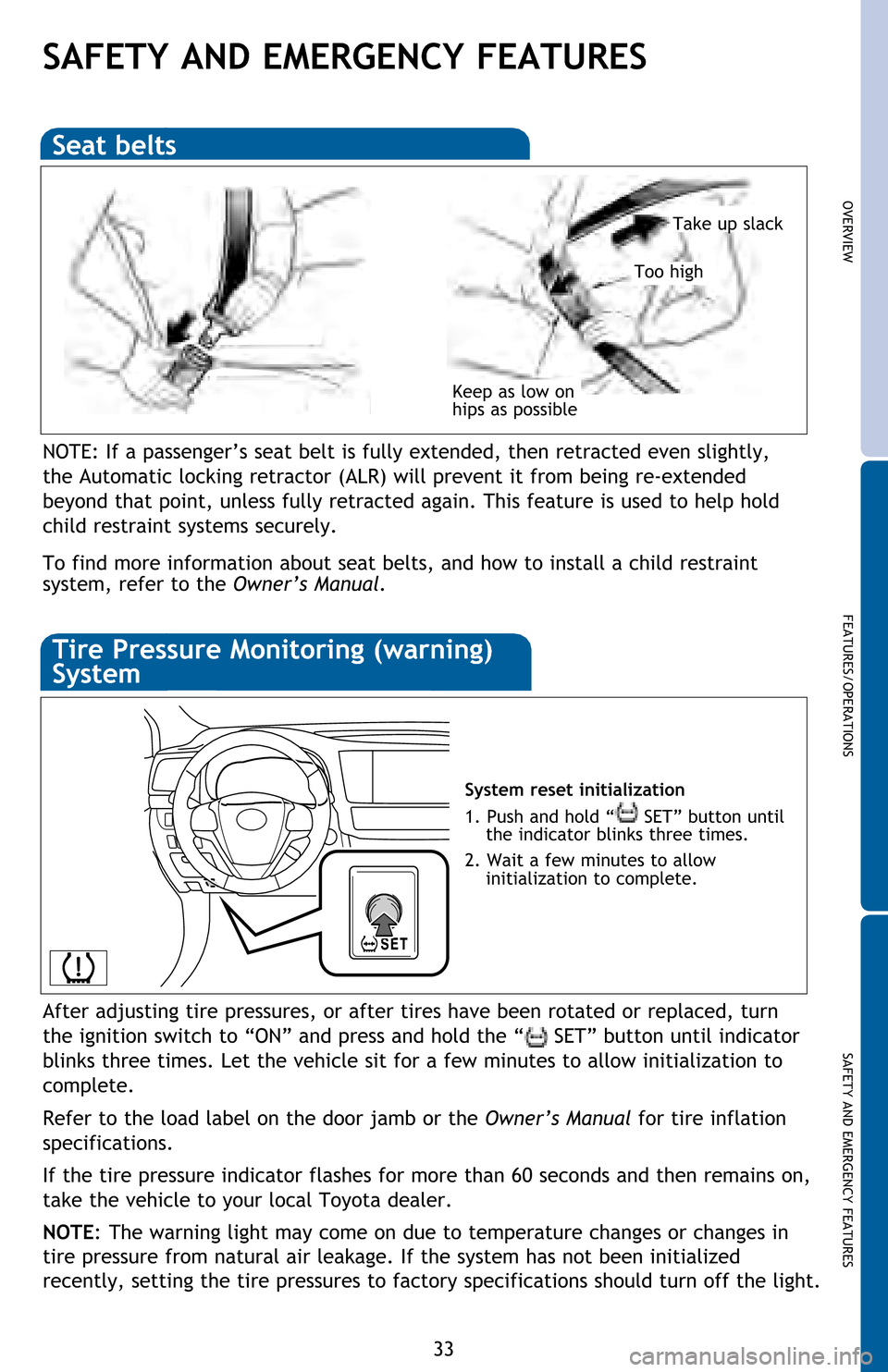Page 5 of 52
OVERVIEW
FEATURES/OPERATIONS
SAFETY AND EMERGENCY FEATURES
3
Automatic air conditioning
Type A
Type B
Lower center console switches
Seat heater/ventilator switches1
Power Liftgate (back door) main switch (inside glove box)1
“ENGINE START STOP” button (Smart Key)1
Ignition (standard key)1
Tilt and telescopic steering lock release
Fuel tank door opener
Hood lock release lever
Automatic High Beam (AHB) switch
1
Blind Spot Monitor (BSM) switch1
Lane Departure Alert (LDA) switch1
Power Liftgate (back door) switch
Intuitive parking assist switch (rear parking sonar)1
Heated steering wheel switch1
Windshield wiper de-icer switch1
1
If equipped 2 Refer to the “Navigation System Owner’s Manual.”3
Refer to the “2016 Entune™ Audio Quick Reference Guide.”
Page 12 of 52
10
FEATURES/OPERATIONS
Automatic transmission
* The “ENGINE START STOP”/ignition switch must be “ON” and the brake pedal
depressed to shift from Park.
Shift the shift lever to “S” position from “D” position.
+: Upshift (push and release)
-: Downshift (pull and release)
Downshifting increases power going uphill, or provides engine braking downhill.
For best fuel economy during normal driving conditions, always drive with the shift
lever in the “D” position.
“S” (Sequential) mode
Park*
Reverse
Neutral
Drive
“S” mode
Door locks
LockUnlock
Unlock
Lock
Page 13 of 52
OVERVIEW
FEATURES/OPERATIONS
SAFETY AND EMERGENCY FEATURES
11
Steering lock release
With Smart Key system Without Smart Key system
PushTurn Turn
Turn
Auto lock/unlock
Automatic door locks can be programmed to operate in two different modes, or
turned OFF.
-Doors lock when shifting from Park.
-Doors lock when the vehicle speed goes above approximately 12 mph.
-Doors unlock when shifting into Park.
Vehicles without Smart Key system
-Doors unlock when the ignition switch is set from “ON” to “ACC” or “LOCK” and
driver’s door is opened.
Vehicles with Smart Key system
-Doors unlock when the “ENGINE START STOP” switch is set to OFF and driver’s
door is opened.
Refer to the Owner’s Manual for more details.
Parking brake
Set: Depress
Release: Depress again
Page 18 of 52
Windshield wipers & washers
16
Power outlets-12V DC & 120V AC (if equipped)
Instrument panel
(12V DC)
The “ENGINE START STOP”/ignition switch must be in the “ACC” or “ON” position
to be used.
Center console
(12V DC)
Single wipe
Interval wipe
Off
Push to Wash and wipe
Rear
Front-Intermittent
Front-Auto (Rain-sensing)
1 Intermittent windshield
wiper frequency adjustment
Rotate to increase/decrease
wipe frequency.
2 Rain-sensing windshield
wipers Rotate to increase/
decrease sensor sensitivity.
(if equipped)Temporary
operation
Rain sensing
(AUTO)
Low
HighAdjust sensitivity2
Pull to wash
and wipe
Interval wipe Mist
Slow
Fast Adjust frequency
1
Pull to wash
and wipe
Rear center console
(120V AC)Rear center console
(12V DC)
Page 26 of 52

24
Pre-Collision System (PCS) (if equipped)
The Pre-Collision System uses a radar sensor and camera sensor to help detect
vehicles and pedestrians in front of your vehicle. If the system determines that
the possibility of a frontal collision with a vehicle or pedestrian is high, the system
warns the driver to take evasive action while the potential brake pressure is
increased to help the driver avoid collision or reduce the impact to the vehicle and
its occupants.
Note: PCS is enabled each time the engine switch is turned to Ignition On. The
system can be disabled/enabled and the warning timing of the system can be
changed.
Pre-collision warning
When the system determines that the possibility of a frontal collision is high,
a buzzer will sound and a warning message will be displayed on the multi-
information display to urge the driver to take evasive action.
Pre-collision brake assist
When the system determines that the possibility of a frontal collision is high, the
system applies greater braking force in relation to how strongly the brake pedal is
depressed.
Pre-collision braking
When the system determines that the possibility of a frontal collision is high, the
system warns the driver. If the system determines that the possibility of a collision
is extremely high, the brakes are automatically applied to help avoid the collision
or reduce the collision speed.
Disabling the Pre-Collision System (PCS)
Enabled
Disabled
FEATURES/OPERATIONS
Page 35 of 52

33
OVERVIEW
FEATURES/OPERATIONS
SAFETY AND EMERGENCY FEATURES
SAFETY AND EMERGENCY FEATURES
Keep as low on
hips as possible
Take up slack
Too high
Seat belts
System reset initialization
1. Push and hold “
SET” button until
the indicator blinks three times.
2. Wait a few minutes to allow
initialization to complete.
Tire Pressure Monitoring (warning)
System
After adjusting tire pressures, or after tires have been rotated or replaced, turn
the ignition switch to “ON” and press and hold the “
SET” button until indicator
blinks three times. Let the vehicle sit for a few minutes to allow initialization to
complete.
Refer to the load label on the door jamb or the Owner’s Manual for tire inflation
specifications.
If the tire pressure indicator flashes for more than 60 seconds and then remains on,
take the vehicle to your local Toyota dealer.
NOTE: The warning light may come on due to temperature changes or changes in
tire pressure from natural air leakage. If the system has not been initialized
recently, setting the tire pressures to factory specifications should turn off the light.
NOTE: If a passenger’s seat belt is fully extended, then retracted even slightly,
the Automatic locking retractor (ALR) will prevent it from being re-extended
beyond that point, unless fully retracted again. This feature is used to help hold
child restraint systems securely.
To find more information about seat belts, and how to install a child restraint
system, refer to the Owner’s Manual.